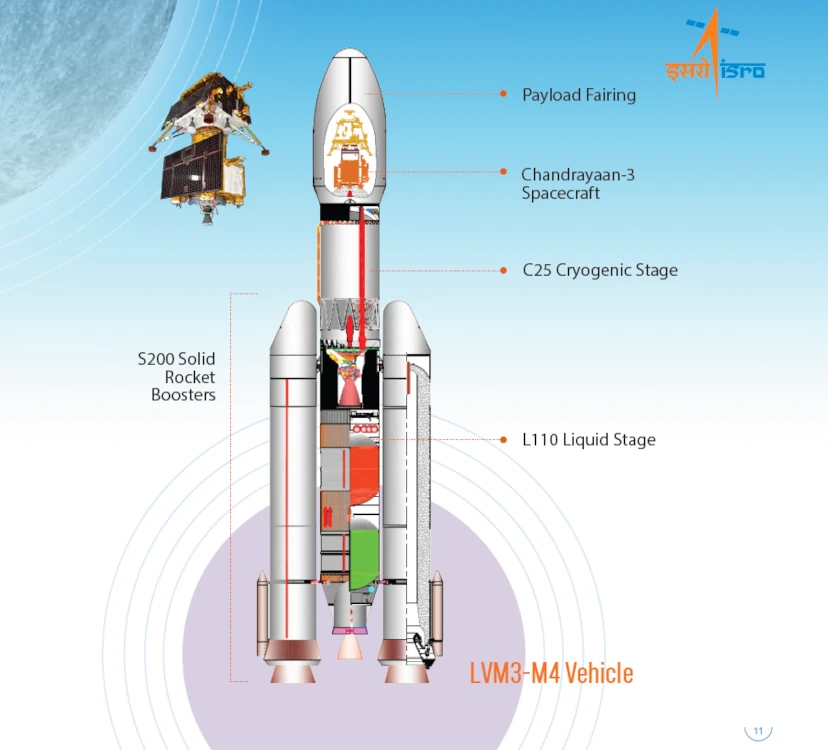The cryogenic upper stage of the LVM3 M4 launch vehicle has completed an uncontrolled re-entry into the atmosphere of the Earth, according to the Indian Space Research Organisation (ISRO). The Chandrayaan-3 spacecraft was successfully launched into orbit on July 14, 2023, and this stage was crucial to the success of the launch attempt.
LVM3 is ISRO’s latest heavy-lift launch vehicle designed to send 4000 kg spacecraft into GTO (Geosynchronous Transfer Orbit) at a low cost. It is a three-stage vehicle with two solid strap-on motors (S200), one liquid core stage (L110), and a cryogenic upper stage with high thrust (C25). With 204 tonnes of solid fuel, the S200 solid motor is one of the world’s largest solid boosters. The L110 stage has 115 tonnes of liquid propellant and a dual-liquid engine configuration. In contrast, the C25 Cryogenic upper stage has a wholly indigenous high-thrust cryogenic engine (CE20) with a fuel loading of 28 tonnes. The vehicle’s length is 43.5 metres, with a gross lift-off weight of 640 tonnes and a payload fairing diameter of 5 metres.
The uncontrolled re-entry into the atmosphere of Earth occurred at approximately 2:42 p.m. on Wednesday, November 15. It was anticipated that it would impact in the North Pacific Ocean, according to ISRO. According to a more straightforward explanation, the phrase “uncontrolled re-entry” refers to the fact that the drop into the atmosphere of the Earth is not steered or regulated, which makes it difficult to anticipate where it will land accurately.
ISRO said that the final path of the re-entering object did not pass over India.
The space agency stated that the rocket body, which was assigned the NORAD identification number 57321, was a component of the vehicle that successfully placed the Chandrayaan-3 spacecraft into its intended orbit, which was 133 kilometres by 35,823 kilometres with an inclination of 21.3 degrees.
Following the “25-year norm” established by the Inter-Agency Space Debris Coordination Committee (IADC), the launched object re-entered the atmosphere 124 days after it was launched. This rule suggests that items currently in low-Earth orbit should either re-enter or be removed within 25 years to reduce the amount of debris accumulating in space.
The object’s precise orbital features and decay dynamics may be responsible for 124 days duration between launch and re-entry. The amount of time it takes for an object to return to the atmosphere of Earth through the process known as “natural orbital decay” is influenced by several factors, including its mass, the conditions of the atmosphere, and its altitude. In addition, the dimensions and aims of the mission might have made it necessary to contemplate an orbit to fulfil particular operational requirements.
‘Natural orbital decay’ refers to the gradual decrease in the altitude and size of an object’s orbit over time due to various factors, primarily atmospheric drag. As an object orbits Earth, it encounters trace amounts of particles in the outer atmosphere. This interaction creates a drag force opposite to the object’s orbital motion, causing it to lose energy and altitude. Over time, this process reduces the object’s orbital height until it eventually re-enters Earth’s atmosphere.
After launching Chandrayaan-3, the rocket’s upper stage was made safe through ‘passivation’, ensuring the removal of any remaining fuel and energy sources. This step aligns with global guidelines, showing India’s dedication to maintaining sustainable use of outer space. Simply put, ‘passivation’ means making the rocket stage inactive and safe to prevent accidental issues, supporting responsible space practices.

‘Passivation’ of a cryogenic rocket stage is achieved through several methods:
- All remaining propellants are purged from the rocket’s engines and tanks, ensuring no residual fuel.
- The rocket’s batteries and power systems are discharged and disconnected, removing any remaining energy sources.
- All valves, lines and connectors are closed or sealed to prevent any accidental fuelling or ignition.
The rocket stage is then carefully monitored to remain inert and safe. This meticulous process guarantees that the rocket poses no threat to Earth, other satellites, or future space missions, following international guidelines and promoting sustainable space practices.
These activities are typically carried out through ‘command control’ systems. ‘Command control’ involves remotely commanding and controlling the various processes and systems involved in passivating the cryogenic rocket stage. Engineers and technicians use ground-based control systems to send commands to the rocket and its onboard systems to initiate the purging of propellants, discharge of power systems, closure of valves and connectors and other necessary steps in the passivation process. The command control systems allow for precise control and monitoring of the activities, ensuring they are executed accurately and safely.
The Launch Vehicle Mark-3 (LVM-3) rocket making possible India’s third journey to the Moon, Chandrayaan-3, took off from the second launch pad at the Satish Dhawan Space Centre in Sriharikota on July 14.
India was the first country to land in the Moon’s south polar region on August 23, making it the fourth country to land on the Moon safely. The Chandrayaan-3’s Lander module made a soft landing on the Moon’s surface.
